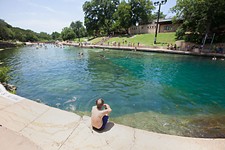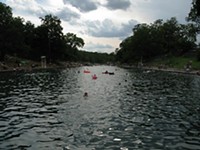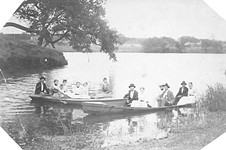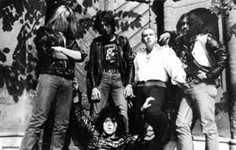The Battle for Barton Springs: A Brief Timeline
Twenty years of progress
By Michael King, Fri., Aug. 3, 2012
Note: This timeline is selected from a much longer online chronology of events in Austin's environmental history, a work-in-progress posted online.
1974-1980: Burgeoning highway construction and unregulated development in the Barton Creek watershed and the recharge zones of the Edwards Aquifer begin to threaten the Central Texas water that nourishes Barton Springs.
1982-83: Work begins on the Circle C development in Southwest Austin, and City Council approves four Municipal Utility Districts to serve Circle C.
1987: The Texas Legislature enacts House Bill 4, barring a city from altering water quality rules once a development project has begun.
1988: Circle C opens to homebuyers. Freeport-McMoRan Inc. proposes the Barton Creek Planned Unit Development, an extensive 4,000-acre project.
1989: Three environmental groups and the conservation district sue the Texas Department of Transportation to halt construction of the southern extension of MoPac.
1990: After an all-night meeting, City Council rejects the Barton Creek PUD; citizens form a movement to strengthen the 1986 Comprehensive Watersheds Ordinance, under the acronym SOS: "Save Our Springs." Council enacts a four-month moratorium on new development in the watershed.
1991: Council tightens watershed ordinance to enforce "zero degradation" of Barton Creek and Barton Springs but approves a "compromise" ordinance over citizen protests. The Save Our Springs Coalition begins a petition drive to put the SOS Ordinance on the ballot.
1992: The SOS Coalition files more than 30,000 signatures calling for the SOS ordinance; after a court fight, Council schedules an SOS election for Aug. 8. Austin voters overwhelmingly approve the SOS ordinance. The Save Our Springs Legal Defense Fund is incorporated to defend the ordinance from expected legal challenges.
1993: The Legislature enacts Senate Bill 1029 to grandfather developments with permits filed prior to subsequent municipal water quality regulations; Gov. Ann Richards vetoes. Barton Springs salamander first described as distinct species of salamander, Eurycea sosorum.
1994: U.S. Fish & Wildlife Service proposes classifying the Barton Springs salamander as an endangered species.
1995: U.S. F&W postpones decision on listing the Barton Springs salamander. Gov. George W. Bush approves new laws restricting Austin's regulatory powers. A Texas Parks & Wildlife report recommends additional developmental restrictions to protect the salamander.
1996: SOS Legal Defense Fund changes its name to Save Our Springs Alliance.
1997: A biological survey counts a record 188 Barton Springs salamanders. U.S. F&W puts the salamander on the endangered species list but declares that development conforming to state and local water-quality regulations does not violate Endangered Species Act.
1998: The Texas Supreme Court upholds the SOS Ordinance, saying "such limitations are a nationally recognized method of preserving water quality ... the City has the right to significantly limit development in watershed areas."
1999: The Lege enacts HB 1704, again grandfathering major planned watershed developments under old water quality regulations.
2000: City Council approves a settlement agreement with Circle C Ranch developer Gary Bradley, decreasing planned density; enviro groups split on the settlement. A city study finds increasing levels of conductivity, sulfates, turbidity, and total organic carbon in Barton Springs water. The Austin office of the Fish & Wildlife Service declares the "continued existence of the Barton Springs salamander is in jeopardy, and state and local regulations are inadequate to prevent pollution in the watershed."
2001: F&W issues a draft biological opinion that water quality is deteriorating in Barton Springs. SOS sues the EPA and F&W over failure to enforce the F&W draft opinion that the EPA is not protecting endangered species from overdevelopment.
2002: City staff scientists report continuing deterioration of water quality in Barton Springs. The 10th anniversary of the SOS Ordinance is celebrated at Barton Springs Pool. Envision Central Texas is founded, hoping to improve regional planning.
2003: Toxic chemicals are discovered in Barton Springs Pool sediment, source undetermined. The city of Kyle extends a development ban, pending better regulation. Wal-Mart plans, then cancels a southwest store over the aquifer recharge zone; Austin considers a big-box ban in environmentally sensitive areas.
2004: A hydrocarbon pollution scare closes Barton Springs for 90 days; the city determines the source is coal-tar sealants used on parking lots. The city reopens Barton Springs Pool after concluding swimming is safe, and plans to clean up nearby pollution sources. The Lower Colorado River Authority moves to provide water for developments along Hamilton Pool Road, extending environmental battles westward. Increasing regional growth moves cities to search for new water sources.
2005: The city seeks more bond money for conservation lands. U.S. Fish & Wildlife proposes a recovery plan for Barton Springs salamander. Buda rock quarry in Barton Springs recharge zone spurs legal fight. LCRA extends additional water service to developments in Western Travis County. An agreement allows a Lowe's store near Sunset Valley. Legislature moves to require compensation for environmental regulation of private property. AMD plans Southwest Lantana campus over the recharge zone. The city plans to shut Green Water Treatment Plant and redevelop the site. Federal standards on impervious cover for development are weakened, and made optional. Proposed redevelopment in Oak Hill sparks a lively debate.
2006: City ban on coal-tar parking lot sealants takes effect. Battle over AMD's Lantana campus continues. "Clean Water, Clean Government" petition drive is launched for city charter propositions on water protection and government transparency; a legal dispute ensues over the ballot language. Initial plan to build a new water treatment plant in Guerrero Park is rejected by council. Charter propositions are defeated.
2007: Dripping Springs considers weakening water-protection rules. Debate begins over development along Town Lake (Lady Bird Lake). A documentary film on Barton Springs, The Unforeseen (by Laura Dunn) is released. After recent court defeats, SOSA files for bankruptcy. City begins a master plan to improve facilities at Barton Springs Pool (Deep Eddy is also being rebuilt). City proposes revising SOS ordinance to allow redevelopment in watershed with less impervious cover, greater water-quality controls.
2008: City buys 3,000 acres of water protection lands and easements in Hays County, plans the Violet Crown Trail. AMD dedicates its new Lantana campus, donates $1.5 million to environmental groups. Hays County considers an agreement that would allow Belterra development to release treated effluent into surface waters in recharge zone. New floodplain maps take effect in Travis County. Debate rages over the Oak Hill land use map and proposed development. The proposed Wildflower Commons development near Oak Hill is debated and eventually canceled. Dahlstrom Ranch sells development rights in 375 acres to Hays County, the Hill Country Conservancy, and the city of Austin.
2009: City Council approves Water Treatment Plant No. 4 near the Balcones Canyonlands Preserve. City proposes to cut 29 Zilker Park/Barton Springs Pool trees threatened by drought; opposition and review results in only a few trees being cut. City revises the Heritage Tree ordinance. City discovers substantial deterioration in the pool bypass tunnel and plans repairs. Serious drought persists throughout Central Texas; LCRA and other agencies impose stricter water limits, which are lifted at year-end due to improved conditions.
2010: Plans proceed for a major cleaning and repair of Barton Springs Pool. Vandals block a sewage line in Southwest Austin, spilling 250,000 gallons of sewage into the aquifer. Travis County imposes a one-year ban on development in western Travis County over the Trinity Aquifer. A federal study confirms that coal-tar sealants are a major nationwide source of water sediment pollution. Poet Susan Bright, defender of the Springs, dies.
2011: A city cleanup closes the pool for three months. City continues to revise the comprehensive plan, emphasizing less sprawl and more compact growth patterns. The drought resumes, with intense summer heat. City buys a 611-acre parcel of conservation lands in Hays County, another piece of the 9,000-acre Violet Crown Trail. Repair work on the pool is delayed by drought and low water flow.
2012: Drought persists, with some summer rain relief in Central Texas. Westside neighborhoods see a jump in private well-drilling for landscapes, with unregulated and unknown effects on aquifer. After much debate, the City Council adopts the Imagine Austin Comprehensive Plan, emphasizing compact and sustainable growth. City plans for an urban rail line are again postponed, and a November bond proposal (including bathhouse renovations at Barton Springs) is anticipated at $400 million. Debate continues over proposed renovations to the pool site, especially southside. Work proceeds on a flood tunnel under Waller Creek, expected to prevent floods and allow major redevelopment. A rainy July eases the Austin drought, but lake levels remain low.
Got something to say on the subject? Send a letter to the editor.














